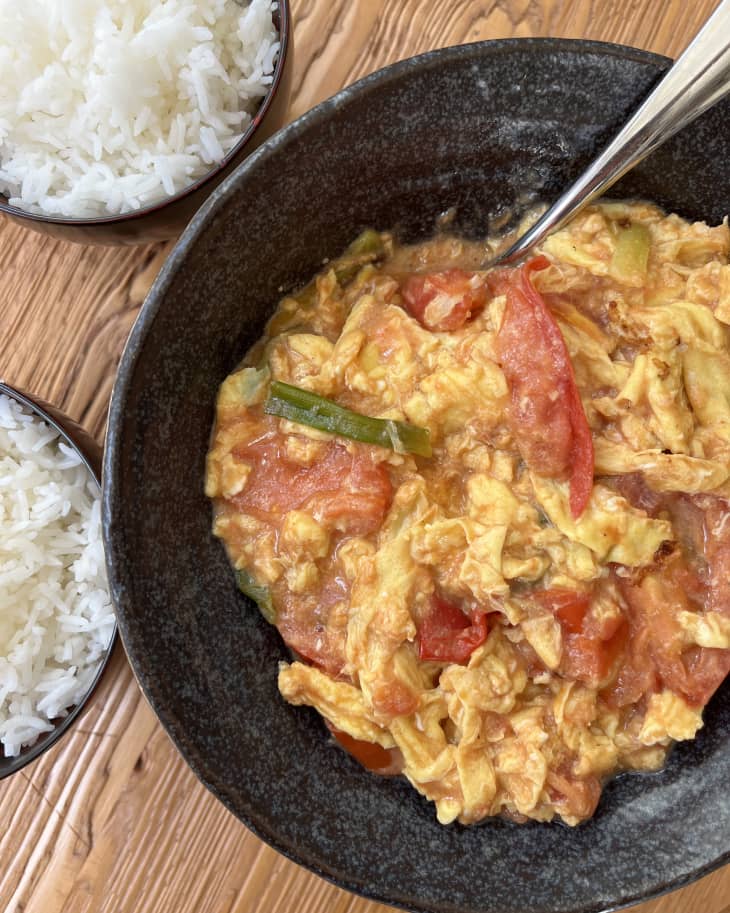This Is the Only Chinese Stir-Fried Tomatoes and Eggs Recipe That Comes Close to My Grandmother’s
I ate dinner at my grandmother’s house most nights when I was growing up. My full-time working parents were wise enough to delegate cooking to someone else, and we all benefited because my grandmother was an excellent cook. We ate traditional Chinese meals, with multiple dishes, served with long-simmered soup and fragrant small bowls of rice.
Most of my comfort foods still have origins at that big table. And stir-fried tomatoes with beef and soft scrambled eggs was one of those dishes. It was also the only tomato dish I liked eating when I was a kid. It’s also a dish rarely seen at Chinese restaurants. For a while, I despaired that I’d never taste it again. Then I saw Francis Lam’s version for the New York Times. I made it exactly as written, and one bite transported me back to those dinners with extended family gathered around the big table, my grandmother sitting happily at the head.
Many tomato dishes either keep the tomatoes raw or slow-cook them into sauces until they fall apart — but this stir-fry is somewhere in the middle. It cooks the tomatoes just long enough to release some of their juices and mellow out the tartness, while leaving a bit of a bite in the middle. I love it because it creates a gingery, sweet-tart sauce studded through with silky eggs that I happily devour over rice. Lam’s version doesn’t contain any beef like my grandmother’s version did, but I actually prefer that now for simplicity and ease of cooking.
Get the recipe: Francis Lam’s Chinese Stir-Fried Tomato and Eggs
How to Make Francis Lam’s Chinese Stir-Fried Tomato and Eggs
Like with all stir-fries, prep is the name of the game here — you need to have all the ingredients ready before you even turn on the stove because it comes together so quickly. There are three main parts to get ready: Beat eggs with some seasonings, mix together the sauce (and yes, ketchup here is key!), and cut up the produce (tomatoes, ginger, and scallions).
Once the stove turns on and the wok heats up, things happen in mere minutes. Soft scramble the eggs with scallions until they’re just set, then return them to the bowl you beat them in. Cook the ginger until fragrant, then add in the tomatoes and stir-fry until they start to soften around the edges. Add in the sauce and simmer briefly until thickened, then return the eggs to the wok and toss to break up the curds and heat them through. What you end up with is soft, silky, sweet, savory, and comfort in a bowl when eaten over steaming white rice.
If You’re Making Francis Lam’s Chinese Stir-Fried Tomato and Eggs, a Few Tips
- The tomatoes don’t have to be perfect. Usually I would encourage you to buy the ripest, best tomatoes you can get your hands on, preferably at the farmers market. But I remember my grandmother making these with rock-hard, barely red tomatoes and the dish still turned out great. So just get what’s available. Even plum or Roma tomatoes will work here.
- Don’t overcook the tomatoes. The tomatoes will keep cooking as the sauce simmers and the scrambled eggs warm through. If you cook them for too long in the middle, they’ll fall apart and the skin will separate from the flesh.
- Ketchup is key. Many similar recipes for this dish skip the ketchup, but for me, it adds the signature touch of sweetness and gives the sauce a nice texture. Don’t skip it!
- You can slice the ginger instead. If you want to make prep go faster or prefer to have the flavor of ginger without actually biting into little bits (my preference), just thinly slice the ginger and give it a whack with the flat side of a knife to bring out the flavors. Cook as directed and just skip eating the pieces of ginger.
- You can halve the amount of eggs. This stir-fry is heavy on the eggs, while my grandmother’s version was heavier on the tomatoes. I personally like halving the egg mixture but keeping everything else the same.
